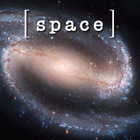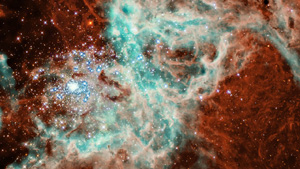
|
30 August 2007 Astronomers examining a microwave anomaly in the area of the constellation Eridanus, southwest of Orion, report having discovered a massive void, far larger than anything seen or theorized to date. The empty space, more than 1 billion light-years in diameter, contains no galaxies, stars or visible nebula, and appears to lack even dark matter. The discovery could alter cosmology as conducted through advanced physics, as it would require an as yet non-existent explanation for such a massive "hole", where no gravitational forces or microwave traces of the Big Bang appear to linger. This suggests a new set of physical laws or properties not yet observed, tested or theorized. A massive 'hole' in the fabric of space-time, if it can rightly be conceived of as a 'hole' or void, forces science to re-examine many of the presumptions about how relativity and quantum physics help describe the shape of the universe. It implies a significant interruption in the process of expansion and complication which appears to exist elsewhere in the universe, and for that, scientists will need to conceive of or demonstrate the existence of a force powerful enough to repel or consume all other forms of energy and matter. It could be that the billion-light-year void is not a void at all, but a kind of space or matter we have no way of detecting, thus giving the appearance of a space without space, kinetic forces or matter. Theoretical physics will immediately begin to grapple with the problem, which could become a landmark puzzle, possibly capable of aiding in the explanation of what sort of forces could have led to the singularity known as the Big Bang. [s]
RELATED STORIES: A new breakthrough in propulsion technology may enable a fuel-free engine with no moving parts to use microwaves to push satellites through space and automobiles on earth. The science is complicated and controversial, but appears to be sound and takes advantage of Einstein's landmark theory of relativity to turn contained microwaves into a propulsion system, in the form of a non-mechanical engine. [Full Story] PHYSICISTS IN JAPAN PLAN TO CREATE NEW UNIVERSE IN LAB A radical new project could permit human beings to create a "baby universe" in a laboratory in Japan. While it sounds like a dangerous undertaking, the physicists involved believe that if the project is successful, the space-time around a tiny point within our universe will be distorted in such a way that it will begin to form a new superfluid space, and eventually break off, separate in all respects from our experience of space and time, causing no harm to the fabric of our universe. [Full Story] BEYOND THE BIG BANG, THE MEMBRANE MULTIVERSE The 'universe' we know as all-encompassing may actually be just one of many such distinct self-contained, self-sustaining phenomena, with distinct physical properties and corresponding physical laws and tendencies, unified membrane cosmologies adrift in a 'superfluid' soup, at times colliding with incredible energy diffusion, creating whole new universes. [Full Story] REVOLUTIONARY HUBBLE TELESCOPE FIRST CASUALTY OF MARS BUDGET SHIFT NASA has announced it will no longer fund maintenance for the Hubble telescope. While the cost of maintaining and refurbishing the telescope is high, its scientific yield is virtually without parallel. Many of the most important discoveries in astronomy in recent years have been achieved through use of the Hubble. It is now thought that the telescope has only a 50% chance of surviving till 2007. [Full Story] |
||||||||||||
|
|||||||||||||

